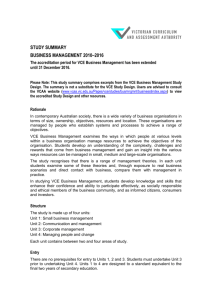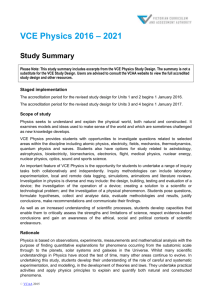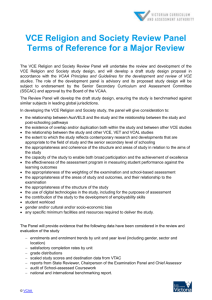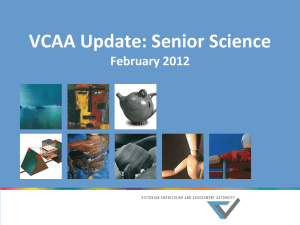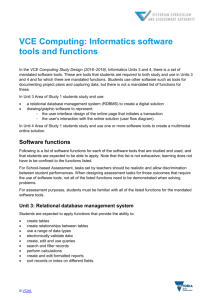VCE Physics Summary of Changes
advertisement
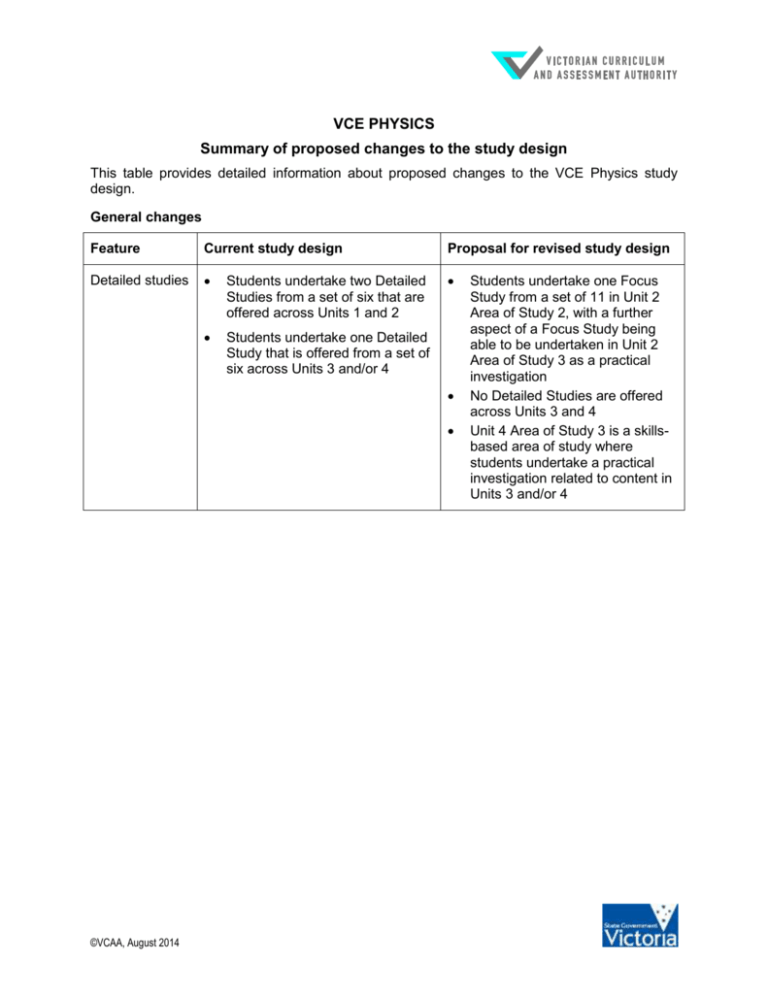
VCE PHYSICS Summary of proposed changes to the study design This table provides detailed information about proposed changes to the VCE Physics study design. General changes Feature Current study design Proposal for revised study design Detailed studies Students undertake two Detailed Studies from a set of six that are offered across Units 1 and 2 Students undertake one Detailed Study that is offered from a set of six across Units 3 and/or 4 ©VCAA, August 2014 Students undertake one Focus Study from a set of 11 in Unit 2 Area of Study 2, with a further aspect of a Focus Study being able to be undertaken in Unit 2 Area of Study 3 as a practical investigation No Detailed Studies are offered across Units 3 and 4 Unit 4 Area of Study 3 is a skillsbased area of study where students undertake a practical investigation related to content in Units 3 and/or 4 VCE PHYSICS SUMMARY OF PROPOSED CHANGES Specific changes Section Current study design Proposal for revised study design Scope of study A single Rationale covers both proposed Scope of study and Rationale Explains aspects of the broad discipline of physics that is included in VCE Physics Rationale Explains the importance of studying VCE Physics, including postsecondary pathways Aims Includes a set of nine VCE Physics aims Proposes set of two VCE Physicsspecific aims and a set of seven generic aims which apply to all VCE sciences (Biology, Chemistry, Environmental Science, Physics and Psychology) Key science skills A set of key skills is described under three general headings A set of key science skills is described under seven general headings which apply to all VCE sciences, with elaborations specific to VCE Physics Unit questions No unit titles or questions are included in the current study design Unit questions are designed to link concepts and ideas across the unit and to reflect the inquiry nature of science Unit 1: How can the unseen be explained? Unit 2: How do observations shape knowledge? Unit 3: How does energy relate to nature? Unit 4: Why are light and matter so challenging to explain? Area of study questions Area of study has short phrases as titles Area of study has questions as titles which are designed to enable exploration of the concepts and ideas related to the topics within the area of study Key knowledge sub-headings Key knowledge is listed as a set of dot points Key knowledge dot points are listed under sets of sub-headings ©VCAA, August 2014 2 VCE PHYSICS SUMMARY OF PROPOSED CHANGES Section Current study design Proposal for revised study design Unit 1 Area of Study 1 Nuclear physics and radioactivity nuclear stability radioactive decay origin, detection, penetration and effects on humans of α, β and γ radiation effects of ionising radiation on living things and the environment nuclear transformations and decay series diagrams natural and artificial isotopes neutron absorption and production of artificial radioisotopes risks in the use of nuclear reactions and radioactivity Can the Universe be explained? Topics: the origin and fate of the Universe the composition of the Universe scientific exploration of the origin and composition of the Universe Electricity electric circuits resistance in series and parallel circuits modelling of simple electric circuits and household electricity connections electric shock practical investigations of the operation of simple circuits safe use of electricity How can thermal effects be explained? Topics: Thermodynamics principles Thermodynamics and global warming How can electricity be explained? Topics: concepts used to model electricity circuit electricity using electricity electrical safety Unit 1 Area of Study 2 Unit 1 Area of Study 3 Detailed study (first selection from a choice of six) This is a new area of study related to cosmology and including the Big Bang theory, the Standard Model and string theory. There is a focus on how we know what we know about the Universe. This is a new area of study. Students explore thermodynamics though one of more of three contexts: the car, the home and/or Earth Content is similar to current Unit 1 Area of Study 2 ©VCAA, August 2014 3 VCE PHYSICS SUMMARY OF PROPOSED CHANGES Section Current study design Proposal for revised study design Unit 2 Area of Study 1 Motion vectors and scalars straight-line and non-uniform motion in a straight line forces weight application of Newton’s three laws of motion work Hooke’s law for an ideal spring energy transfers and transformations momentum impulse How can motion be described? Topics: concepts used to model motion forces and motion energy and motion Wave-like properties of light transverse waves calculations of wavelength, frequency, period, and speed of travel of light waves reflection, refraction and total internal reflection light as a wave and a particle polarisation visible light colour Proposed set of 11 Focus Studies: What are stars? Is there intelligent life beyond Earth’s solar system? How do forces act on the human body? How can AC electricity charge a DC mobile phone? How do heavy things fly? How do fusion and fission compare as viable nuclear energy power sources? How is radiation used in medical imaging and diagnosis? How do particle accelerators and colliders work? How can human vision be extended? How do instruments make music? How can physics be applied to improve performance in ball sports? Unit 2 Area of Study 2 Content is similar to current Unit 2 Area of Study 1: inclusion of g = 9.8 inclusion of the concept of torque and analysis of structures, from the current Unit 3 and 4 Detailed Study of ‘Materials and their use in structures’ deletion of reference to ‘weight’ Content contains new material in addition to content derived from current Areas of Study and Detailed Studies across Units 1 to 4 ©VCAA, August 2014 4 VCE PHYSICS SUMMARY OF PROPOSED CHANGES Section Current study design Proposal for revised study design Unit 2 Area of Study 3 Student-designed practical investigation related to waves, fields or motion new Area of Study with a skills focus investigation question relates to content in Unit 2 Areas of Study 1 and/or 2 student designed and conducted involves collection of primary qualitative and/or quantitative data Unit 3 Area of Study 1 Motion in one and two dimensions application of Newton’s three laws of motion in one and two dimensions uniform circular motion projectile motion momentum and impulse work energy transformations gravitational fields and forces weight, apparent weight, weightlessness, apparent weightlessness satellite motion How do things move when there is no contact? Topics: fields and interactions effects of fields application of field concepts Electronics and photonics operation of electronic circuits parallel and series circuits opto-electronic devices transfer of information in analogue form design, investigation and analysis of circuits for particular purposes voltage characteristics of amplifiers How efficient is the delivery of electrical energy to homes? Topics: generation of electricity transmission of electricity impact of electricity Unit 3 Area of Study 3 ©VCAA, August 2014 Detailed study (second selection from a choice of six) Content relates to fields: derived from several areas of study in the current study design related to electric, magnetic and gravitational fields includes Coulomb’s law and the magnetic force on a moving charge Content is similar to current Unit 4 Area of Study 1 5 VCE PHYSICS SUMMARY OF PROPOSED CHANGES Section Current study design Proposal for revised study design Unit 3 Area of Study 2 Not included Is there a limit to how fast things can go? Topics Newtonian theories of motion Einsteinian theories of motion relationships between force, energy and mass relativity Content is similar to current Unit 3 Area of Study 1, but with the inclusion of relativity Unit 4 Area of Study 1 Unit 4 Area of Study 2 ©VCAA, August 2014 Electric power application of a vector field model to magnetic phenomena calculations related to current carrying wires simple DC motors magnetic flux generation of emf DC motors, DC generators and AC alternators transformer action power supply use of transformers in electricity distribution system How can waves explain the behaviour of light? Topics: properties of mechanical waves light as a wave changing direction polarisation of light Interactions of light and matter Young’s double slit experiment diffraction patterns photoelectric effect light as a wave and a particle de Broglie wavelength of matter momentum of photons and of matter of the same wavelength atomic absorption and emission spectra absorption of photons by atoms How are light and matter similar? Topics: behaviour of light matter as particles or waves similarities between light and matter Content similar to content from current Unit 2 Area of Study 2 but includes: calculations of Brewster’s Angle applications of polarisation Content: similar to current content in Unit 4 Area of Study 2 new content includes Heisenberg’s uncertainty principle 6 VCE PHYSICS SUMMARY OF PROPOSED CHANGES Section Current study design Proposal for revised study design Unit 4 Area of Study 3 Student-designed practical investigation related to waves, fields or motion new area of study with a skills focus investigation question relates to content in Unit 3 and/or 4 may be undertaken in either Unit 3, Unit 4 or across both Units 3 and 4 student designed and conducted involves collection of primary quantitative data results presented as a scientific poster Units 3 and/or 4 scientific poster template Not included Scientific poster template provided which includes identified sections and suggested marking scheme Practical logbook Practical logbook not mandated Students are required to maintain a practical logbook for record, authentication and assessment purposes Schoolassessed Course School-assessed Coursework is weighted across five outcomes Proposed School-assessed Coursework is equally weighted across 6 outcomes ©VCAA, August 2014 Detailed study (one from a choice of six) 7 VCE PHYSICS SUMMARY OF PROPOSED CHANGES ASSESSMENT Units 1 and 2 Assessment tasks in the current and proposed study designs are similar although some have been updated to reflect current assessment practice and the nature of the discipline. Current Unit 1 assessment tasks Proposed Unit 1 assessment tasks Assessment tasks for this unit are: A practical investigation (student designed or adapted) and A selection from the following: an annotated folio of practical activities a data analysis a multimedia or web page presentation a response to a media article a summary report of selected practical investigations including maintenance of a logbook a written report a test (short answer and extended response). For Outcomes 1 and 2: Assessment tasks for this unit should be selected from the following: report of a practical investigation (studentdesigned or adapted) using an appropriate format, for example, a scientific poster, practical report, oral communication or digital presentation. and A selection from the following: annotated folio of practical activities data analysis media response summary report of selected practical investigations including maintenance of a logbook modelling activity reflective learning journal/blog related to selected activities or in response to an issue test comprising multiple choice and/or short answer and/or extended response. The assessment tasks may be written, oral or multi-modal. ©VCAA, August 2014 8 VCE PHYSICS SUMMARY OF PROPOSED CHANGES Current Unit 2 assessment tasks Proposed Unit 2 assessment tasks Assessment tasks for this unit are: A practical investigation (student designed, adapted or extended) and A selection from the following: an annotated folio of practical activities a data analysis a multimedia or web page presentation a response to a media article a summary report of selected practical investigations including maintenance of a logbook a written report a test (short answer and extended response). Assessment tasks for this unit should be selected from the following: For Outcomes 1 and 2: A selection from the following: annotated folio of practical activities data analysis media response summary report of selected practical investigations including maintenance of a logbook modelling activity reflective learning journal/blog related to selected activities or in response to an issue test comprising multiple choice and/or short answer and/or extended response. The assessment tasks may be written, oral or multi-modal. and For Outcome 3: report of a practical investigation (studentdesigned or adapted) using an appropriate format, for example, a scientific poster, practical report, oral communication or digital presentation. ©VCAA, August 2014 9 VCE PHYSICS SUMMARY OF PROPOSED CHANGES Proposed Unit 3 assessment The nature of assessment tasks in the current and proposed study designs are similar although only two Outcomes exist currently for Unit 3 and three Outcomes are included in the proposed study design. Some assessment tasks have been updated to reflect current assessment practice and the nature of the discipline. An indication of time for the task is intended to provide greater comparability in the scope of the tasks across classes and schools, and to reduce School-assessed Coursework load for teachers and students. Outcomes Outcome 1 Analyse gravitational, electrical and magnetic fields, and use these to explain the operation of motors and particle accelerators Outcome 2 Analyse and evaluate an electricity generation and distribution system. Outcome 3 Investigate motion and related energy transformations experimentally, analyse motion using the Newtonian model in one and two dimensions, and describe the motion of objects moving at very large speeds using Einsteinian models. Total marks Marks allocated* 30 30 30 Assessment tasks For Outcomes 1, 2 and 3: At least one different task for each Outcome selected from: annotations of at least two practical activities from a practical logbook report of a student investigation analysis of data including generalisations and conclusions media analysis/response extended response questions reflective blog A test (short answer and extended response) (approximately 50 minutes per task) 90 *School-assessed Coursework for Unit 3 contributes 20 per cent. ©VCAA, August 2014 10 VCE PHYSICS SUMMARY OF PROPOSED CHANGES Proposed Unit 4 assessment Assessment tasks in the current and proposed study designs are similar for Outcomes 1, 2 and 3 although some have been updated to reflect current assessment practice and the nature of the discipline. An indication of time for the task is intended to provide greater comparability in the scope of the task across classes and schools, and to reduce School-assessed Coursework load for teachers and students. The proposed Outcome 3 task may be undertaken in Unit 3, Unit 4, or across Unit 3 and Unit 4, but will be reported as part of Unit 4 School-assessed Coursework and mirrors the current assessment task for Unit 4 Outcome 3. A template has been constructed for production of the associated scientific poster task to assist in staged completion and authentication of student work. Outcomes Outcome 1 Apply wave principles to analyse, interpret and explain wave phenomena. Outcome 2 Provide evidence for the nature of light and matter, and analyse the data from experiments that provide this evidence. Outcome 3 Undertake an investigation related to the motion of particles or matter, and present methodologies, findings and conclusions as a scientific poster. Total marks Marks allocated* 30 30 30 Assessment tasks For Outcomes 1 and 2: At least one different task for each Outcome selected from: annotations of at least two practical activities from a practical logbook report of a student investigation analysis of data including generalisations and conclusions media analysis/response extended response questions reflective blog (approximately 50 minutes) Structured scientific poster according to VCAA template (maximum 1000 words) 90 *School-assessed Coursework for Unit 4 contributes 20 per cent. ©VCAA, August 2014 11



